#Sustainable Textiles
Explore tagged Tumblr posts
Text
youtube
Every year, nearly 100 billion items of clothing are produced – and 65% of them end up in a landfill within 12 months. New technologies in textile recycling may be able to curb that waste – while producing a host of sustainable materials.
#planeta #recycling #fastfashion #circulareconomy #textileindustry
We're destroying our environment at an alarming rate. But it doesn't need to be this way. Our new channel Planet A explores the shift towards an eco-friendly world — and challenges our ideas about what dealing with climate change means. We look at the big and the small: What we can do and how the system needs to change. Every Friday we'll take a truly global look at how to get us out of this mess.
Follow Planet A on TikTok: https://www.tiktok.com/@dw_planeta?la...
Credits:
Report: Dave Braneck
Video Editor: Frederik Willmann
Supervising Editor: Michael Trobridge
Fact Check: Alexander Paquet
Thumbnail: Ém Chabridon
Read More:
McKinsey - Scaling Textile Recycling in Europe
https://www.mckinsey.com/industries/r...
NY Times - Will We Ever Be Able to Recycle Our Clothes Like an Aluminum Can?
https://www.nytimes.com/2022/11/30/st...
EU Strategy for Sustainable and Circular Textiles https://environment.ec.europa.eu/stra...
Chapters:
00:00 Intro
00:46 Textile waste's global impact
02:47 How do you actually recycle clothes?
03:50 New approaches to textile recycling
07:41 What else needs solving?
11:41 Can we even recycle all the clothes we make?
#DW Planet A#solarpunk#fashion#fashion industry#fast fashion#fashion waste#circular fashion#recycling#textiles#textile industry#sustainable fashion#sustainable textiles#textile recycling#Youtube
7 notes
·
View notes
Text
Exploring the Cooling Fabrics Market: Trends, Opportunities, and Applications

The Cooling Fabrics Market is making waves across industries, driven by the growing demand for innovative, comfortable, and sustainable materials. These fabrics, designed to regulate temperature and enhance comfort, are gaining traction in diverse applications, including apparel, medical care, bedding, automotive interiors, home furnishings, and military gear. This article delves into the trends, key applications, and future outlook of the cooling fabrics market.
The cooling fabrics market is projected to grow from USD 2.4 billion in 2023 to USD 3.6 billion by 2028, at a CAGR of 7.7%.
Market Drivers: What’s Fueling the Demand?
Rising Awareness of Thermal ComfortConsumers are increasingly prioritizing fabrics that provide optimal thermal regulation. This demand is fueled by climate change, which has heightened the need for clothing and materials that ensure comfort in extreme temperatures.
Technological InnovationsAdvances in fabric technology, including phase-change materials (PCMs), microencapsulation, and nanotechnology, have enabled the development of high-performance cooling fabrics. These innovations are addressing specific needs in sectors like healthcare and automotive.
Sustainability and Eco-Conscious ConsumersThe growing focus on sustainability has led manufacturers to explore eco-friendly cooling fabric solutions. Many are incorporating recycled materials and reducing their carbon footprint to appeal to environmentally conscious buyers.
Key Applications Across Industries
Apparel & ClothingCooling fabrics have revolutionized the fashion and sportswear industry. From athletic apparel to casual wear, these fabrics wick moisture, regulate body temperature, and provide UV protection. Athletes and outdoor enthusiasts benefit from performance-enhancing features that improve endurance and comfort during activities.
Medical & HealthcareIn healthcare, cooling fabrics are utilized in patient gowns, bedding, and medical wraps. These fabrics help manage patient temperatures, reduce the risk of heat-related complications, and ensure overall comfort. For instance, cooling blankets are gaining popularity in hospitals to address fever management and post-surgical care.
Bedding & MattressSleep products like mattresses, bed sheets, and pillowcases are now being infused with cooling technologies to improve sleep quality. These fabrics regulate temperature and prevent overheating, catering to individuals who suffer from night sweats or live in warmer climates.
Automotive & TransportationIn the automotive industry, cooling fabrics are used in car seats, steering wheel covers, and interiors to enhance comfort during long drives. This is especially relevant in regions with hot climates, where maintaining a cool cabin temperature is crucial for driver and passenger satisfaction.
Home FurnishingThe demand for cooling curtains, upholstery, and cushions is rising in the home furnishing sector. These products not only enhance the aesthetic appeal of living spaces but also contribute to energy savings by reducing the reliance on air conditioning.
Military & DefenseCooling fabrics are becoming a staple in military uniforms and gear. Soldiers operating in extreme environments benefit from these fabrics' ability to regulate body temperature, prevent heat stress, and ensure mobility during missions.
Emerging Trends in the Cooling Fabrics Market
Smart FabricsThe integration of smart technology with cooling fabrics is an emerging trend. Fabrics embedded with sensors can monitor body temperature and adjust cooling properties in real-time, catering to sectors like sports and healthcare.
Expansion of Sustainable SolutionsWith increasing environmental concerns, manufacturers are focusing on biodegradable cooling fabrics and reducing the use of synthetic materials. Partnerships with sustainability-focused organizations are also driving innovation in this space.
Customization for Niche ApplicationsCompanies are tailoring cooling fabrics for specific end-use industries, such as advanced military uniforms or high-performance athletic gear. Customization is expected to remain a key differentiator in the competitive landscape.
Challenges Facing the Industry
Despite its promising growth, the cooling fabrics market faces challenges. High production costs and the complexity of developing advanced cooling technologies pose barriers to widespread adoption. Additionally, educating consumers and industries about the long-term benefits of cooling fabrics remains essential for market penetration.
Future Outlook
The global cooling fabrics market is expected to witness significant growth in the coming years, driven by rising investments in research and development and expanding applications across industries. Asia-Pacific is emerging as a key growth region, owing to its booming textile industry and increasing demand for advanced fabrics in apparel and automotive sectors.
As innovations continue to shape the market, industries such as medical, home furnishing, and military are likely to explore more sophisticated applications for cooling fabrics. This presents lucrative opportunities for manufacturers to tap into untapped markets and cater to evolving consumer needs.
To know more Download PDF Brochure :
Cooling fabrics are more than just a trend—they represent a shift towards smarter, more sustainable material solutions across industries. For experts in apparel, healthcare, bedding, automotive, home furnishing, and defense, this market offers endless possibilities for innovation, comfort, and performance enhancement.
#Cooling Fabrics Market#Apparel Industry#Medical Textiles#Bedding and Mattress#Automotive Interiors#Military and Defense#Sustainable Textiles
0 notes
Text
Future-Ready; RSWM’s plans for a sustainable and automated future !!
RSWM Limited, the flagship company of LNJ Bhilwara Group is a name synonymous with excellence in the textile industry. One of India’s largest manufacturers and exporters of synthetic and blended spun yarns, the company has also carved a niche for itself with its knitted fabrics.
Explore our media coverage and discover how we’re making headlines. Click below to read more!
0 notes
Text
Heimtextil 2025: Make an Impact with Globstar Exhibitions in Frankfurt

Heimtextil 2025 is set to be the go-to global event for professionals in the textile industry, taking place in Frankfurt, Germany. As the largest international trade fair for home and contract textiles, Heimtextil is known for showcasing the latest trends, technologies, and innovations in the world of fabrics, textiles, and interior designs. For any brand that deals with textiles or interior décor, this is the event to mark on your calendar.
As a top-tier Exhibitions Stand Builder in Europe, Globstar Exhibitions is dedicated to helping you elevate your presence at Heimtextil 2025. With custom booth designs and local production in Europe, we ensure that your brand makes a lasting impression at this prestigious event. In this blog, we’ll explore why participating in Heimtextil is essential for your brand, the benefits of a professionally designed exhibition stand, and why Globstar Exhibitions is the perfect partner to make your trade show presence a resounding success.
What is Heimtextil 2025?
Heimtextil is the world’s leading trade fair for textiles, fabrics, and interior décor. Hosted annually in Frankfurt, this event attracts industry professionals from across the globe, including designers, manufacturers, retailers, and decorators. With a focus on innovation and sustainable solutions, Heimtextil 2025 will be the launchpad for new products, trends, and business ideas.
The fair will feature more than 3,000 exhibitors from around the world, all showcasing the latest in textile solutions for home and contract environments. From upholstery fabrics and curtains to smart textiles and sustainable materials, Heimtextil is the place where the future of the textile industry unfolds.
However, with thousands of exhibitors competing for attention, standing out requires a bold and innovative exhibition strategy. That’s where Globstar Exhibitions can make all the difference.
Why Heimtextil 2025 is Essential for Your Brand
Exhibiting at Heimtextil 2025 offers numerous benefits for your business, whether you’re looking to expand your reach, launch new products, or connect with international buyers. Here’s why your presence at Heimtextil is critical for your brand’s growth:
Showcase Your Products to a Global Audience: Heimtextil draws visitors and exhibitors from over 135 countries, providing an unmatched opportunity to showcase your products to a global audience. Whether you’re a supplier of fabrics, an interior designer, or a producer of textile machinery, this event allows you to present your latest offerings to key decision-makers in the industry.
Discover Emerging Trends and Innovations: As the industry’s leading event, Heimtextil is known for unveiling the latest trends and innovations. From sustainable textile solutions to cutting-edge design concepts, the fair is where future trends are set. By participating, you can not only showcase your products but also stay ahead of industry shifts, ensuring your brand remains at the forefront of textile innovation.
Build Valuable Business Relationships: Heimtextil is the ultimate networking platform for textile professionals. With thousands of visitors, exhibitors, and industry experts in attendance, the fair offers countless opportunities to connect with potential clients, suppliers, and partners. Establishing strong business relationships at Heimtextil can lead to long-term growth and expansion.
Strengthen Your Brand Visibility: In today’s competitive market, brand visibility is crucial. Participating in a renowned trade fair like Heimtextil allows you to strengthen your brand’s visibility and reputation. A well-designed exhibition stand can create a powerful brand presence, attracting the attention of buyers, designers, and industry leaders.
Why Your Exhibition Stand at Heimtextil 2025 Matters
At an event as significant as Heimtextil 2025, your exhibition stand is much more than just a display space—it’s your brand’s physical representation. A strategically designed and expertly built booth can:
Capture Attention Instantly: In the bustling environment of a trade fair, your booth has just seconds to capture the attention of passersby. A visually striking, custom-designed stand will ensure that your brand stands out amid the competition. Whether through innovative design, strategic lighting, or interactive displays, your exhibition stand should be an immediate magnet for visitors.
Showcase Your Brand's Expertise: Your exhibition stand serves as a platform to showcase your expertise and innovation. By creating a space that reflects your brand’s strengths—whether it’s cutting-edge textile technology or sustainable fabric solutions—you communicate your brand’s authority and leadership in the market.
Enhance Visitor Engagement: A well-designed stand doesn’t just look good—it engages visitors. With interactive elements like digital displays, product demos, and immersive experiences, you can keep visitors at your booth longer and foster meaningful interactions. This engagement is crucial for generating leads and leaving a lasting impression on potential clients.
Differentiate Your Brand from Competitors: With thousands of exhibitors at Heimtextil 2025, standing out is essential. A unique, custom-built exhibition stand can differentiate your brand from competitors. By showcasing your products and solutions in a way that aligns with your brand’s values and messaging, you ensure that your brand remains memorable long after the event.
How Globstar Exhibitions Can Help You Succeed at Heimtextil 2025
At Globstar Exhibitions, we specialize in creating custom exhibition stands that not only capture attention but also elevate your brand's presence at major trade shows like Heimtextil. Here’s how we can help:
Custom-Built Exhibition Stands: We know that every brand has a unique identity and vision. That’s why we create custom exhibition stands tailored to your brand’s goals, target audience, and messaging. Whether you’re looking for a minimalist design that emphasizes product innovation or a bold, interactive stand that draws in visitors, our team will design and build a stand that perfectly aligns with your brand.
Local Production in Europe: With production facilities located in Europe, Globstar Exhibitions offers fast, cost-effective solutions for European trade fairs. Our local production ensures quicker delivery times, high-quality craftsmanship, and the ability to make last-minute adjustments if needed. Whether you’re exhibiting in Frankfurt, Paris, or elsewhere, our proximity to key trade fair locations means seamless project management from start to finish.
Sustainable Solutions: Sustainability is a growing priority for brands across all industries, and Globstar Exhibitions is committed to providing eco-friendly solutions. We offer sustainable stand designs that utilize reusable materials, energy-efficient lighting, and environmentally conscious construction methods. By choosing a sustainable exhibition stand, you not only reduce your environmental impact but also align your brand with the growing demand for eco-friendly practices.
End-to-End Project Management: From initial design concepts to on-site installation, Globstar Exhibitions manages every aspect of your exhibition stand. Our full-service project management ensures that your stand is delivered on time, on budget, and to the highest standards. Whether you need a small stand for a niche audience or a large, multi-faceted booth, we’ll take care of every detail.
Expertise in European Trade Shows: As a leading Exhibitions Stand Builder in Europe, we have extensive experience working with European trade shows. We understand the specific requirements and regulations for exhibiting at events like Heimtextil, ensuring that your stand complies with all local guidelines while making a bold statement.
Maximizing Your Impact at Heimtextil 2025: A Comprehensive Strategy
To ensure a successful exhibition at Heimtextil 2025, it’s essential to implement a comprehensive strategy that maximizes your impact before, during, and after the event:
Pre-Event Marketing: Before the event, use social media and email marketing to build anticipation around your presence at Heimtextil 2025. Share updates about your stand design, new products, and exclusive offers for visitors. This will help attract the right audience to your booth.
Onsite Engagement: During the event, focus on creating meaningful interactions with visitors. Ensure your staff is well-trained to engage with potential clients, answer questions, and showcase your products effectively. Use technology like interactive displays or virtual reality to create an immersive experience for attendees.
Post-Event Follow-Up: After Heimtextil 2025, follow up with the contacts you made during the event. Personalized emails, social media outreach, and phone calls can help turn leads into long-term business relationships. Provide additional information about your products, schedule follow-up meetings, and stay connected with prospects.
Why Choose Globstar Exhibitions for Heimtextil 2025?
By choosing Globstar Exhibitions as your stand builder for Heimtextil 2025, you benefit from:
Custom Designs: We create tailor-made stands that reflect your brand’s identity and goals.
Local European Production: With production facilities in Europe, we offer fast, reliable, and cost-effective stand building services.
Sustainable Practices: We provide eco-friendly stand solutions to help your brand go green.
Full-Service Project Management: From design to installation, we handle every aspect of your stand’s creation and delivery.
Trade Show Expertise: Our extensive experience with European trade fairs ensures a smooth, successful exhibition experience.
Conclusion
Heimtextil 2025 in Frankfurt is a prime opportunity for businesses in the textile and interior design industries to showcase their innovations and connect with global audiences. To make the most of this event, a custom-built exhibition stands from Globstar Exhibitions will set your brand apart and drive business success. Contact us today to start planning your stand for Heimtextil 2025 and make a lasting impact at the world’s leading textile trade fair.
#Heimtextil 2025#Textile Innovation#Interior Design Expo#Sustainable Textiles#Exhibition Stand Builder In Europe#Globstar Exhibitions#Trade Show Stand Design#Eco Friendly Exhibits#Frankfurt Trade Show#Custom Exhibition Stands
0 notes
Text
#Sustainable Fabric#silk khadi fabric#organic fabric#fabric linen#clothe store#cotton fabric#silk fabrics#organic fabrics#Eco-Friendly Fabrics#Sustainable Textiles#Organic Cotton#Hemp Fabric#Eco-Conscious Fashion#Sustainable Fashion#Spring Summer 2024 Collection#Slow Fashion#Natural Fabrics#Sustainable Clothing Materials#painted fabric#linen fabric#cottony fabric#fabric#fabrics#online fabrics#satin fabrics#WOOL FABRIC#silk sarees#fabrics linen#sustainable silk sarees#online fabric material
0 notes
Text
Most of this is true and very worth pointing out because a lot of ppl don't know much about source, manufacturing processes or qualities of different fibers.
However I did want to correct the bit about fabric care for rayon. You absolutely can iron and machine wash it. Hell, you can even dye it. You just need to use the right settings. Rayon shrinks easily and can be damaged by high temperatures, but that's easily avoided with a low iron setting (use a pressing cloth too if you're nervous) and cold water washing to be safe. (I honestly put most of mine in warm and occasionally hot without ill effect, but it depends a lot of the garment, if it's a blend, if it was pre-shrunk, etc)
I promise you, rayon is not that hard to take care of.
Oh and also viscose is the same thing too. Tencel, modal, lyocell, viscose, cupro, triacetate, rayon, bemberg, acetate etc. are all fibers produced via a few different variants on the cellulose soup method. The main difference (post-production) comes down to branding and what types of fabric the fibres get woven into. (Though I will add that the acetate family of cellulose fibers is distinct enough to be a separate thing from rayon. Basically it's one of the earliest developed forms of the material, and isn't used nearly as often anymore because it's generally just not as good as later generation cellulose fibers.)
Edit:
I wanted to add something getting discussed in the notes.
Saying Lyocell could forever replace polyester is an exaggeration, it's not a one-to-one substitution, because they have different properties. Poly is tougher and dries faster, making it better for specialized applications like sports or camping gear.
However I agree with the main point, which is that most polyester in clothing could be substituted for something better. That means materials like recycled nylon, organic cotton, responsibly produced wool, etc. in addition to stuff like lyocell. It all depends on intended function of the garment.
“Bamboo is antifungal”
Because it’s rayon
“Eucalyptus fabric is cooling!”
Yeah, because it’s rayon
“We make clothing called seacell out of seaweed!”
Yeah I looked on your website it’s made by the lyocell process, which means-
-wait for it-
It’s fucking rayon!!
Listen. There is a list of actual plant fibers that are directly made into fabric: cotton, linen, ramie, some hemp. I’m sure I’m missing a couple.
But if you’re wondering “huh how did they turn that plant material into fabric,” 99% of the time? It’s RAYON.
All rayon is made by putting plant material in chemical soup, dissolving out everything but the cellulose, and turning the cellulose into filaments/fibers.
The source of the cellulose has zero effect on the eventual fabric.
Rayon made from bamboo or eucalyptus or seaweed is not any better than rayon from any other sources.
Don’t let companies mislead you!
18K notes
·
View notes
Text
Dress for Success: Sustainable Fashion Tips for the Modern Workforce with Sri Shakthi Tex

In today’s dynamic and eco-conscious world, dressing for the office isn’t just about looking professional — it’s also about making ethical and sustainable choices. Sri Shakthi Tex, a leading manufacturer of quality textiles in Erode, offers a stunning range of natural fabrics that are perfect for creating chic and comfortable workwear ensembles.
So, ditch the bland, synthetic suits and embrace the power of conscious fashion! Here are some sustainable style tips to help you achieve a polished and professional look while feeling confident and comfortable all day long:
1. Embrace the Versatility of Natural Fabrics:
Sri Shakthi Tex offers a treasure trove of breathable and eco-friendly fabrics like organic cotton, linen, and rayon. These natural fibers not only drape beautifully but also keep you cool and comfortable throughout the workday.
2. Play with Prints and Patterns:
Subtle prints and textures can add visual interest to your outfit without compromising professionalism. Sri Shakthi Tex boasts a collection of exquisite prints inspired by nature and Indian heritage, perfect for making a statement without going overboard.
3. Invest in Classic Staples:
Build your workwear wardrobe with versatile pieces that can be easily mixed and matched. A crisp white shirt, a well-fitted blazer, and tailored trousers from Sri Shakthi Tex can be adapted to create countless professional looks.
4. Accessorize Wisely:
The right accessories can elevate your outfit and add a touch of personality. Opt for simple yet elegant jewelry, a statement scarf, or a sleek leather bag for a polished finish.
5. Comfort is Key:
Remember, you’ll be sitting and moving around throughout the day, so prioritizing comfort is essential. Choose pieces that allow for freedom of movement without compromising on style. Sri Shakthi Tex’s natural fabrics are naturally soft and breathable, ensuring you stay comfortable all day long.
6. Embrace the Ethical Choice:
By choosing sustainable fabrics from Sri Shakthi Tex, you’re not just making a statement about your personal style, you’re also contributing to a healthier planet and fairer working conditions for textile workers. Sri Shakthi Tex is committed to ethical production practices and sustainable sourcing, making them the perfect choice for the conscious consumer.
Conclusion:
Dressing for success in the modern workplace doesn’t have to be boring or unsustainable. With Sri Shakthi Tex’s quality textiles in erode and these styling tips, you can create a professional and polished look that reflects your commitment to both style and sustainability. So step into the office feeling confident and empowered, knowing that you’re making a positive impact on the planet one outfit at a time.
#Textile Manufacturing#Fabric Production#Textile Industry#Quality Fabrics#Yarn Manufacturing#Weaving Services#Knitting Solutions#Fabric Export#Sustainable Textiles#Textile Innovation#Textile Products#Yarn Suppliers#Dyeing and Finishing#Textile Processing#Apparel Fabrics
0 notes
Text
it occurs to me that some of my tumblr friends who are in the textile and fiber arts fandom, might enjoy listening to this podcast, which i discovered recently and am gradually working my way through.
#threads of sustainability#podcast#fiber arts#textile arts#textiles#sustainability#sustainable textiles
1 note
·
View note
Photo

Field to Fabric: Takahiro Hasegawa's Ode to Linen in 'One Field, One T-shirt'
#fashion#minimalism#sustainability#japanese art#takahiro hasegawa#contemporary#the linen project#art#textile art#linen
6K notes
·
View notes
Text
Hemp Upholstery- Sustainble Textiles and Fabric- Nisha Designs
Hemp Upholstery Fabrics

View On WordPress
#ART#colors#hotel design#interiordesigners#interiors#Nisha Designs#residential design#sustainable hemp#sustainable textiles
0 notes
Text
I found a pair of pants at a thrift store which really caught my eye, but had a giant hole in them...which turned out to be value-added, of course. So I filled it in with a big yellow scotch-darning patch:
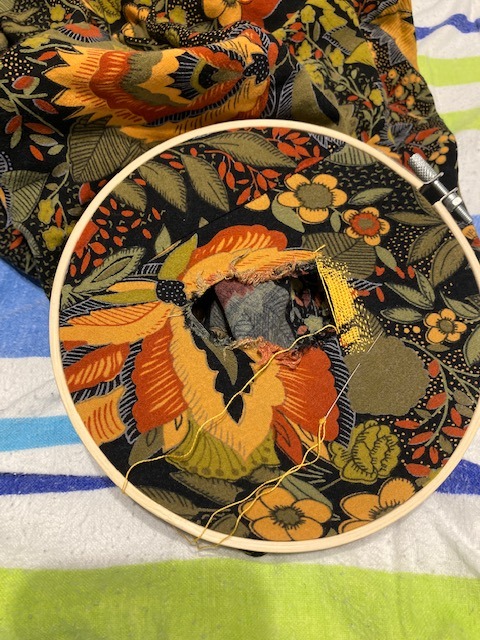
And I was going to leave it with the big yellow blotch because I didn't really have the right colors in my thread box to match the fabric palette for embroidering......but then I was up way too late last night and decided that it would be fine if I just approximated them by using threads of two different colors.....
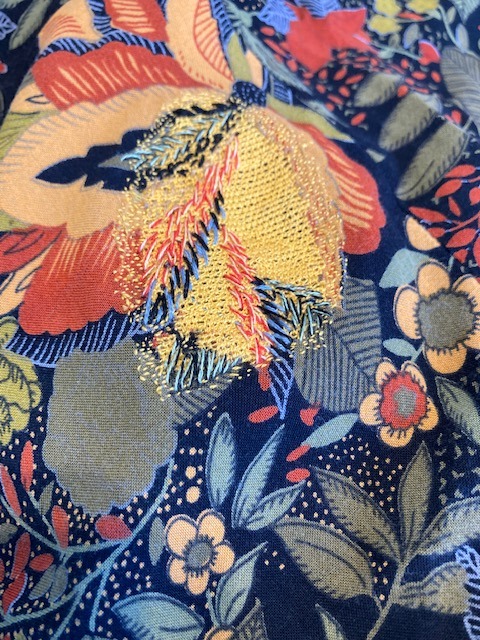
And I think it turned out pretty well!
Distance shot:
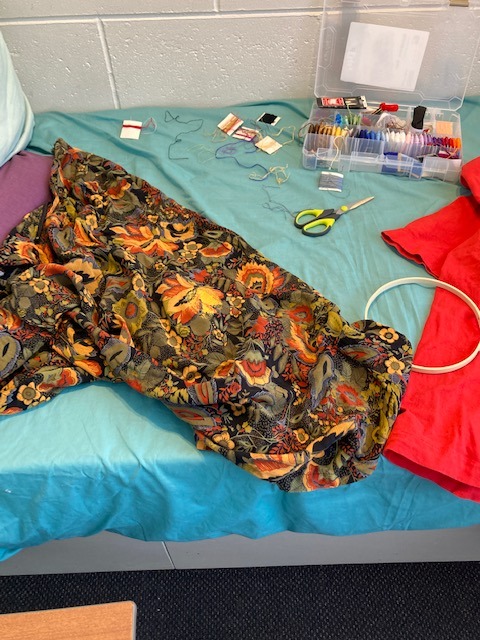
Yay for freehand embroidery practice! The more I do of these, the braver I'm getting!
#visible mending#scotch darning#embroidery#upcycling#patches#slow fashion#sustainable fashion#mending#sewing#fiber arts#textile art#crafts
740 notes
·
View notes
Text
The Morrisian case against fast fashion
Today I discovered that H&M made a William Morris collection some years ago. The heath death of the universe can't come quickly enough. We can stop now. Satire is dead and we killed her.
It's not just the whole concept of H&M using William Morris' designs for their fast fashion which is insanity inducing, but also the critical response it garnered. Like sure, people did realize this is insane and there was a lot of think pieces about it at the time, but I read several of them and they all seem to still miss the point in spectacular way.
The basic premise of these think pieces go along the lines of: "Would William Morris spin in his grave with a speed of light because of the H&M collection of his designs? A difficult question indeed. William Morris was a complicated man. He wanted art to be affordable to everyone. Isn't H&M affordable? That kinda fits. Though probably he would have some concerns about H&M's practices."
On the surface - yes - but like in reality - fuck no. There's no nuance in this particular issue. He talked about many times what he though of the H&Ms of his time, the retailers selling poor quality industrially produced "fashionable" bullshit. We know exactly what he would have thought of H&M. Here's couple of quotes from his 1884 lecture "Art and Socialism", which makes it very clear.
"It would be an instructive day's work for any one of us who is strong enough to walk through two or three of the principal streets of London on a week-day, and take accurate note of everything in the shop windows which is embarrassing or superfluous to the daily life of a serious man. Nay, the most of these things no one, serious or unserious, wants at all; only a foolish habit makes even the lightest-minded of us suppose that he wants them, and to many people even of those who buy them they are obvious encumbrances to real work, thought and pleasure. But I beg you to think of the enormous mass of men who are occupied with this miserable trumpery, from the engineers who have had to make the machines for making them, down to the hapless clerks who sit day-long year after year in the horrible dens wherein the wholesale exchange of them is transacted, and the shopmen, who not daring to call their souls their own, retail them amidst numberless insults which they must not resent, to the idle public which doesn't want them but buys them to be bored by them and sick to death of them."
He is describing the birth of consumerism, which was taking form during his lifetime in the late Victorian Era, which fast fashion is the extreme logical conclusion of, and he fucking hated it. He specifically railed against endless consumerist products, which H&M is the perfect representation of. It was definitely not the art and beauty he believed everyone required and deserved. He makes the distinction often.
"Now if we are to have popular Art, or indeed Art of any kind, we must at once and for all be done with this luxury; it is the supplanter, the changeling of Art; so much so that by those who know of nothing better it has even been taken for Art, the divine solace of human labour, the romance of each day's hard practice of the difficult art of living."
"And here furthermore is at least a little sign whereby to distinguish between a rag of fashion and a work of Art: whereas the toys of fashion when the first gloss is worn off them do become obviously worthless even to the frivolous—a work of Art, be it ever so humble, is long lived; we never tire of it; as long as a scrap hangs together it is valuable and instructive to each new generation. All works of Art in short have the property of becoming venerable amidst decay: and reason good, for from the first there was a soul in them, the thought of man, which will be visible in them so long as the body exists in which they were implanted."
When he thought of popular Art he thought of the craftsmanship of the common people. The art people have made from useful everyday objects with skillful handicrafts. This is what he means by "divine solace of human labour". It's not reverence of Puritanical work ethic, on the contrary, it's the reverence of creation, of the earnest joy people feel when they get to express themselves through their creative pursuits. He certainly didn't believe in work for work's sake, work needed to be worthwhile and enjoyable. He summarized his own position on what labour should be thusly:
"It is right and necessary that all men should have work to do which shall be worth doing, and be of itself pleasant to do; and which should he done under such conditions as would make it neither over-wearisome nor over-anxious."
He urged his middle class audience to reject consumerism (the lecture was for a very much middle class atheist society):
"For I say again that in buying these things: 'Tis the lives of men you buy! Will you from mere folly and thoughtlessness make yourselves partakers of the guilt of those who compel their fellow men to labour uselessly?"
I think it's glaringly obvious H&M and fast fashion in general is what he would consider luxury. Rags of fashion that are just churned out and discarded without thought and produced by compelling people to labour uselessly. It's not popular art that's made by workers and craftsmen, who are able to express themselves through it. There's no agency for the abused workers in H&M's sweatshops, they are not expressing their joy of creation, they are simply labouring uselessly.
Morris didn't shame workers for buying affortable things even if they weren't Art with big A, because that's the problem he despised the whole economic system for, for taking away the popular Art from people, making it inaccessible, and selling back mass produced products with very little practical or aesthetic value. So I don't think he would have problem with people who can only afford fast fashion today. They are the victims of capitalism too, because Art has been taken away from them. But the idea that some of these think pieces had that perhaps the H&M's Morris collection can be good actually if you squint, that H&M has the capacity to bring the art and beauty Morris advocated for for the people, is level of stupidity that's hard to express in words.
Morris didn't believe anything made with exploited labour could be truly beautiful, truly art. In his 1879 lecture "The Art of the People" he put it like this:
"That thing which I understand by real art is the expression by man of his pleasure in labour."
The way I understand this, is that art is communication. Through it we communicate feelings, ideas and thoughts, that is it's purpose. So for that communication to work, for it to be imbued with message, the person making it needs to feel passion and love for it's creation. How can there be love and passion if the hands making the garment belong to a tired exploited worker who has no agency what so ever in their work and can only think about survival to the next day?
Beyond the fundamental exploitativeness of H&M and fast fashion, this collection would still get zero points on aesthetic values from Morris even with his own designs. Because the work itself was such an important part of art for Morris, good design was nothing without good craftsmanship. Good design in his mind was always relative and dependent on it's purpose.
"For everything made by man’s hands has a form, which must be either beautiful or ugly; beautiful if it is in accord with Nature, and helps her; ugly if it is discordant with Nature, and thwarts her; it cannot be indifferent." (The Lesser Arts, 1877)
Here when he says nature, he means the nature of the thing that is made - basically it's purpose and function - and the nature of the materials it's made from. Basically, the design must always be made to bring out the function of the art and the qualities of the material it's made from, not fight against them. This is because he believed handicrafts were uniquely suitable for expressing the love of creation, therefore superior labour, and to really bring out the qualities of the craftsmanship and enjoy the creative process, the design should be suitable for that craft. The other side, which was the joy of using and experiencing art, required the craft to be selected for the suitable purpose. Using poorly functioning furniture for example is not very enjoyable, nor is using clothing that's made from materials that are not suitable for the climactic conditions it's supposed to be used in.
H&M of course utterly fails in this. They use Morris' designs in fully unsuitable ways. They print patterns made for example for wall papers on poor quality fabrics with synthetics dyes they weren't made for. This line from one blog post I came across really got me: "Therefore, without cheapening the artistic value of Morris’ designs, H&M’s collection offers an unparalleled potential for accessibility to them." No. Fuck no. They do in fact cheapen Morris' designs in every single way possible. Literally this is atrocious.
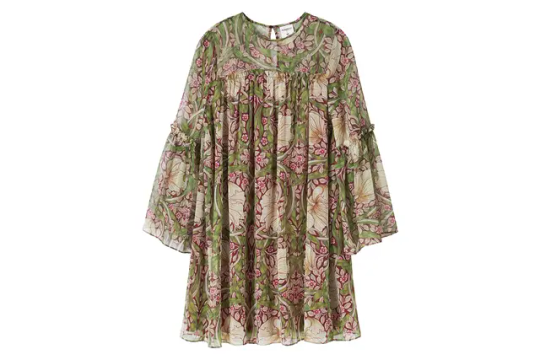
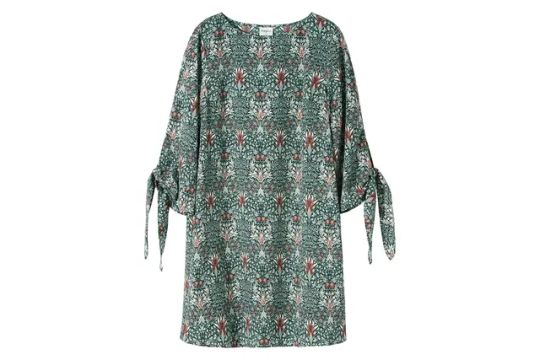
Despite the popular depiction, Morris wasn't in fact against industrial machinery or industrial art even, or at least he wasn't once his views on art and politics matured. He did think technology was useful, but he thought the people should use industrial methods for the benefit of all, not be enslaved by the industrial machine.
"I have spoken of machinery being used freely for releasing people from the more mechanical and repulsive part of necessary labour; and I know that to some cultivated people, people of the artistic turn of mind, machinery is particularly distasteful, and they will be apt to say you will never get your surroundings pleasant so long as you are surrounded by machinery. I don't quite admit that; it is the allowing machines to be our masters and not our servants that so injures the beauty of life nowadays. In other words, it is the token of the terrible crime we have fallen into of using our control of the powers of Nature for the purpose of enslaving people, we care less meantime of how much happiness we rob their lives of." ("How we live and how we might live", 1887)
However, he thought that the designer should approach it the way they approached any craft, by designing for the strengths of the machine work.
"But if you have to design for machine-work, at least let your design show clearly what it is. Make it mechanical with a vengeance, at the same time as simple at possible. Don't try, for instance, to make a printed plate look like a hand-painted one: make it something which no one would try to do if he were painting by hand..." ("Art and the Beauty of the Earth", 1881)
He did use some machinery for fabric and wall paper printing, but he was very intentional about their use. Still his designs weren't made for the type of methods these modern H&M machinery uses and he did for example use natural dyes. Particularly insulting is that some of the H&M clothes are made from viscose, rayon made with viscose method. Viscose method is extremely toxic and is known to cause long term health consequences for the workers and the people in surrounding areas. This has been well proven knowledge for ages. William Morris' wall paper factory in the beginning used the typical method used at the time which involved arsenic, but once he learned this could pose risks for the workers, he changed the method. Many of the new synthetic dyes were toxic at the time, which is the major reason he so favoured natural dyes, known to not cause health issues for workers or pollute the environment.
The question many of these think pieces about the H&M Morris collection posed was, would Morris disapprove and should we care? The first part of that is very easy to answer. Yes. Of course Morris would disapprove. He is currently powering the whole of British Isles with purely the kinetic energy his grave-spinning produces. Should we care though? If you care about Morris' art, if you want to see more of that kind of art in this world, you should care. Morris' art is not about the superficial qualities. Copying his designs and aesthetics and styles, will only lead to hollow imitations, that are exactly what he described the rags of fashion to be; as the shininess of novelty wears off they will reveal themselves to be soulless, useless and utterly empty. This collection is just that. To see more of the kind of art that makes you feel like his art makes you feel, not just something that reminds you of that feeling, you should focus more on the way the art is made and less on the specific aesthetics. If his vision of labour and art was realised, all art produced of course wouldn't be loved by every person, but all of it would be loved by someone, even if that someone was just the maker. And that would be more worthwhile than every single rag of fast fashion.
I will stop William-Morris-posting now and return to my thesis.
The full texts I quoted here:
Art and Socialism The Art of the People The Lesser Arts How We Live and How We Might Live Art and the Beauty of the Earth
#william-morris-posting#fashion#fast fashion#william morris#a&c#arts and crafts movement#fashion history#history#textiles#textile history#sustainability
621 notes
·
View notes
Text
Suggestion of a crafting resource for people to look for in their communities because I didn't know it existed near me and others may not know to look for it!
There's a place in my town called a creative reuse center that is dedicated to reducing material waste and making art materials accessible to the community. The way it works at mine is they take material donations from customers but also from local businesses getting rid of excess materials and other stuff and sell it at a reduced cost. Here they sell some individually priced items, but most of it is by weight at $2/3 per pound. And literally it could be anything you may need for any type of project. There's fabric, yarn, thread, paining supplies, office supplies, old books and magazines for collaging, poster board, paper, and then just like random items that could be used in different projects like cds, corks, empty spools, cardboard tunes, leather, cigar boxes, literally anything.
I got all of this vintage tatting and mending thread (plus some dmc) for literally less than 50 cents the other day.

I saw someone recently who was a teacher walk out with four full grocery bags of crafting supplies for her students for about $40.
At this one they also host community events and classes which I haven't gotten the chance to attend yet but I'm looking forward to it!
Like I said this was something I didn't even know to look for until I came across it mostly by chance, so if you are looking to reduce your crafting waste by buying second hand or lower costs or looking to get rid of and donate some supplies maybe check to see it there's something like that near you!
#fiber arts#cross stitch#bobbin lace#embroidery#handmade#quilting#sewing#crafting#sustainable fashion#sustainability#waste reduction#resources#crafting resource#textile art#art#artist#art resources#artists on tumblr
156 notes
·
View notes
Text

block printed cicada patches on sustainable felt 🌿
etsy
#just did a mini shop update + my summer clearance sale is still going on ✨#mine#my art#art#textile art#fiber art#artists on tumblr#lino print#printmaking#patches#insects#cicada#bugs#patch#slow fashion#red#whimsigoth#naturecore#goblincore#sustainable fashion#traditional art#etsy
185 notes
·
View notes
Text
#organic fabric#organic fabrics#cotton knit fabric#cotton fabric#fabric linen#linen and fabric#Sustainable Clothing#Eco-Friendly Fabrics#Sustainable Textiles#Organic Cotton#Eco-Conscious Fashion#Sustainable Fashion#Spring Summer 2024 Collection#Slow Fashion#Natural Fabrics#Sustainable Clothing Materials#silk khadi fabric#painted fabric#silk fabrics#sewing#fabric#white fabric#fabric organic#organic white fabric
0 notes